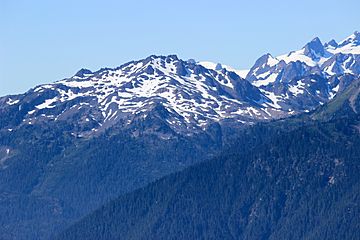Stephen Peak facts for kids
Quick facts for kids Stephen Peak |
|
|---|---|

Stephen Peak from Hurricane Ridge
|
|
| Highest point | |
| Elevation | 6,418 ft (1,956 m) |
| Prominence | 638 ft (194 m) |
| Isolation | 1.62 mi (2.61 km) |
| Parent peak | Mount Carrie (6,995 ft) |
| Geography | |
| Location | Olympic National Park Jefferson County, Washington, US |
| Parent range | Olympic Mountains |
| Topo map | USGS Mount Queets |
| Geology | |
| Age of rock | Eocene |
| Climbing | |
| First ascent | 1961 |
| Easiest route | class 2 scrambling |
Stephen Peak is a tall mountain, about 6,418 feet (1,956 meters) high. It's found inside Olympic National Park in Jefferson County, Washington state. Stephen Peak is the fifth-highest peak in the Bailey Range, which is part of the bigger Olympic Mountains.
On a clear day, you can see Stephen Peak from the visitor center at Hurricane Ridge. It looks like it's to the left of Mount Olympus. Nearby mountains include Mount Ferry to the southeast and Ruth Peak (part of Mount Carrie) to the northwest. Rain and melting snow from the mountain flow into rivers like the Elwha River and Hoh River. The first people to climb to the very top were Kent Heathershaw, Doug Waali, and Robert Wood in 1961.
What's the Weather Like at Stephen Peak?
Stephen Peak is located in a "marine west coast" climate zone. This means it gets a lot of moisture from the Pacific Ocean. Most weather systems come from the Pacific and move towards the Olympic Mountains.
When these weather systems hit the tall mountains, they are forced to rise. This causes them to drop their moisture as rain or snow. Because of this, the Olympic Mountains get a lot of precipitation, especially in winter. Stephen Peak even has a small, unnamed glacier on its east side because of all the snow.
During winter, the weather is usually cloudy. But in summer, high-pressure systems over the Pacific Ocean often bring clear skies. The best months to visit Stephen Peak for views or climbing are July, August, and September.
How Stephen Peak Was Formed
The Olympic Mountains, including Stephen Peak, are made up of different types of rock. These rocks were formed from pieces of old ocean crust and sediments. They were pushed up and folded over time.
The mountains were shaped a lot during the Pleistocene era, which was a long time ago. During this period, huge sheets of ice called glaciers moved across the land many times. These glaciers carved out valleys and peaks as they advanced and then melted away. This process helped create the rugged and beautiful landscape we see today at Stephen Peak.




